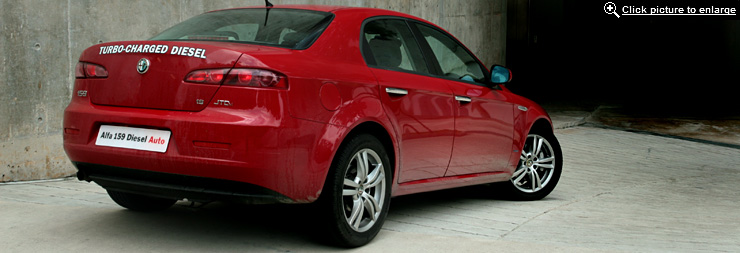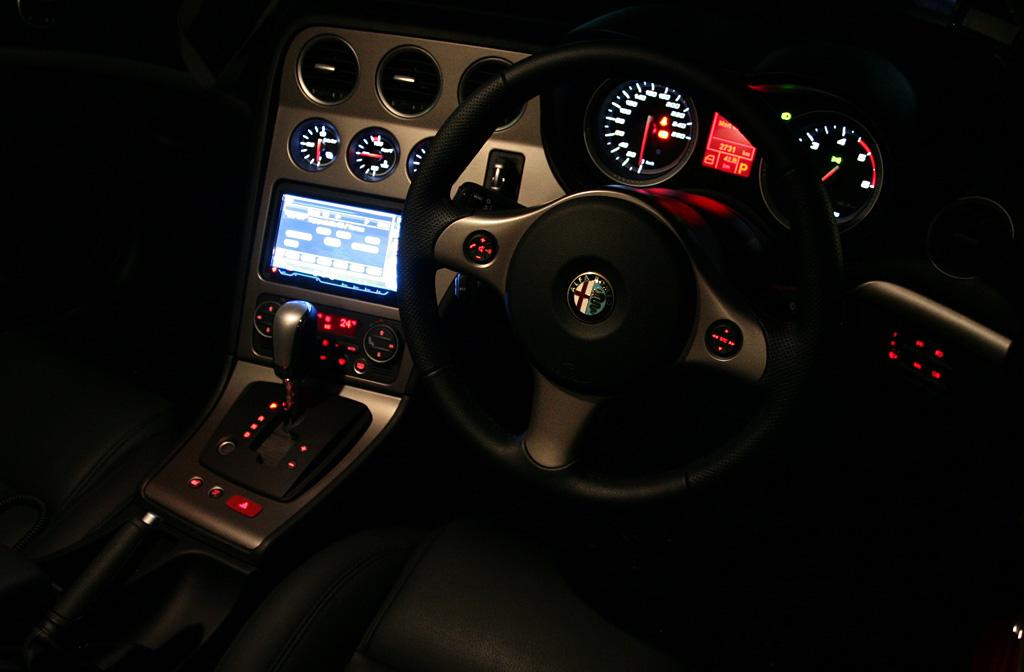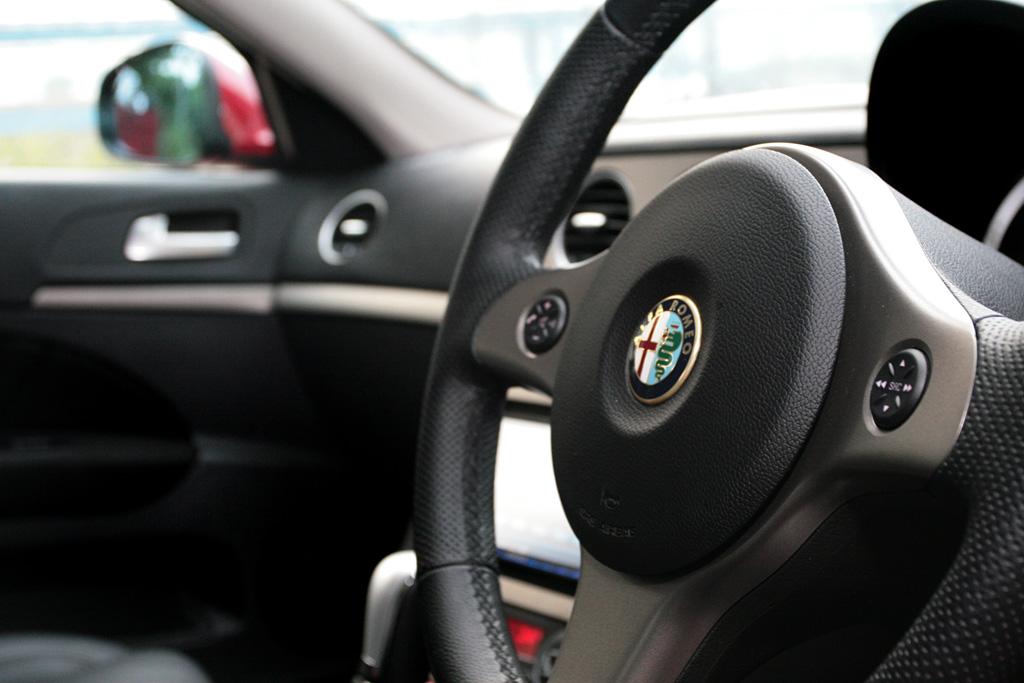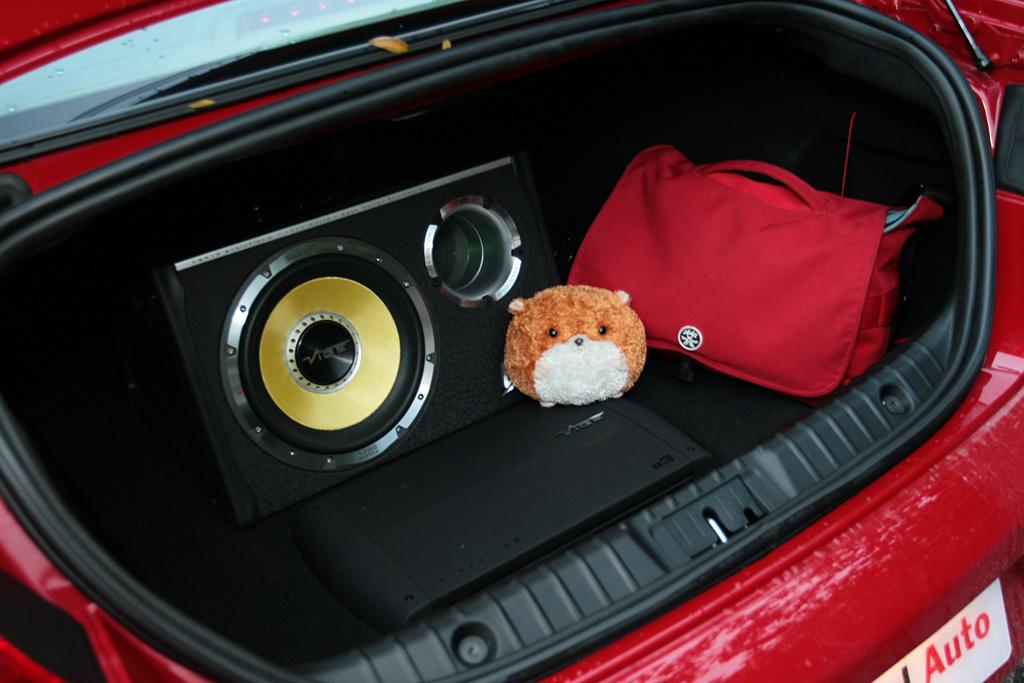Alfa Romeo 159 1.9 JTDM (A) Review
20 Oct 2008|41,822 views
 |
More than anything else in its price range, the 159 has an overtaking presence that no Mondeo, 3-series or C-class rocket can provide. Those beady-eyed headlights and that shark-like front grille will be very daunting to anyone but the richest, most aggressive supercar owner.
Interior
Onto a more subjective topic. Many have come to think of this car's cabin as being dated and counter-evolutionary for an Alfa. But to a large extent, it still is a refreshing alternative to the austere, executively set interiors of Mercedes-Benz, BMW, Saab or Volvo. Build quality has vastly improved, and now, anyone over 160 cm tall receives very decent amounts of rear head and legroom.
It isn't much better than, say, a Volkswagen Jetta or the equivalent Volvo. However, in addition to folding rear seats, boot space is almost on par. It's much bigger than anyone would have expected, and it endows the 159 with large amounts of carrying capacity.
 Dual-zone climate control is of course, standard, and so are electric seats for both driver (with memory) and passenger. There's a sensor for air-quality, amongst other accessories like Bluetooth capability, parking sensors, and lovely colour-coded leather interiors that only the Italians can perfect.
Dual-zone climate control is of course, standard, and so are electric seats for both driver (with memory) and passenger. There's a sensor for air-quality, amongst other accessories like Bluetooth capability, parking sensors, and lovely colour-coded leather interiors that only the Italians can perfect. Our only gripe, really, was the optional aftermarket sound system that would probably send any die-hard Alfisti to his grave. The double-din Kenwood console ruins the flow and consistency of Alfa's beautiful dashboard design, while an unglamorous Lanzar subwoofer was an eye-sore. It robbed us of boot space, and was not a worthy sacrifice of better audio quality. In fact, the entire setup was so badly tuned, none of us could have heard anything apart from boomy, untamed bass.
Not that it was a huge problem though - after fussing with the highly adjustable electronics for a full half an hour, we had managed to get decent levels of sound. But still, it was in no way, justifiable to this Italian beauty's pedigree.
(ed. at this point of time, it's worth mentioning that the writer of this article is considered to be a fussy "audiophile" and a qualified judge of certain car audio competitions. He has Italian-crafted speakers and amplifiers riding in his ironically cranky and non-Italian budget-hatch!)
 |
Chassis
The chassis of the 159 is entirely different from the 156. It is stiffer, more exploitable, and has a revised suspension setup comprising multi-linked rears instead of struts, and new double-wishbones in front. To solve the 156's problem of bottoming out, the anti-dive geometry has been reworked in its entirety, while dampers have silicone-filled bump stops to aid in noise control.
The Brembo co-developed disc brakes are large. They measure at least 305 mm in front and 278 mm out back - almost the same size as the 156 GTA. This grows to almost 330 and 293 mm (front and rear) for the bigger, more powerful V6 models. As always, anti-lock brakes wired to the vehicle dynamics control module is of standard issue.
A low-ratio steering rack is supposed to aid driving pleasure along twisty roads, and we'll touch on that later on.
Engine
The 1.9 JTD isn't a new model. It was part of five engines since the launch of the 159. Fans should be familiar with the 2.2-litre and 3.2-litre V6 variants, and while the diesels are largely a carry over with several minor updates, they're hardly what you might call, lacking. In tax-sensitive Singapore, Alfa Romeo is offering the latest "entry-level," 1,910-cc Multijet.
In line with its German counterparts who are caught in the diesel craze, Alfa stocks one of the industry's more advanced oil burners, complete with a counterbalancing shaft that almost does away with that "clatter" you might otherwise find in a common-rail.
Alfa claims additional gains in efficiency by means of Multijet technology, which is basically the ability to vary injection pressure from the engine speed throughout the rev range. This is irrespective to the amount of diesel being delivered. The latest variant comes with 16-valves and a variable inlet geometry turbocharger that yields an end result of 150 bhp at 4,000 rpm and a huge 320 Nm of torque at just 2,000 rpm.
Driving Impressions
Driving position. Very Italian in nature, you find yourself sitting higher than you might expect even at the lowest setting. Apart from that, it's rather interesting, driving one of these. The first thing you need to ditch is the customary Alfa driving style. You don't blister the revs all the way to the red line every time you charge up the gears as you would in the petrol.
 |
Being an automatic, this didn't seem to be too problematic for ill-disciplined me. Flooring it from an 800 rpm idle, the first 700 rpm or so felt rather flat. Then, the magnificent surge of power and torque suddenly takes effect from 1,500 rpm, and is all over by 4,500 rpm, which is where you need to shift up.
That may not sound like much, but consider that a typical diesel tops out between 4,000-6,000 rpms as opposed to 6,500-8,000 revs in a petrol engine. There's also enough acceleration in between to rocket you from 30 to 70 km/h in a little under 4 seconds when you're in third, and that's discounting the century dash.
 Well, we did miss that "buzzy" JTS tune whilst hustling it around, although we honestly believe that you won't be able to tell it apart from the petrol variant whilst cruising inside the car.
Well, we did miss that "buzzy" JTS tune whilst hustling it around, although we honestly believe that you won't be able to tell it apart from the petrol variant whilst cruising inside the car. The 5-speed "Q-Tronic" torque converter automatic that we had sampled was much smoother and more satisfying to use than Alfa's Selespeed. We were perfectly content leaving it in self-shifting mode even under hard driving. Nonetheless, a sequential shift-it-yourself mode was a welcome extra, of course.
The biggest change would probably be in the handling department. Now here's an Alfa with an unbelievably, genuinely good ride. It's quiet beyond north-south highway speed limits and as refined as an entry-level Mercedes-Benz C-class. The low-ratio steering bites perfectly into corners with no hints of under or oversteer at the limits of grip. Complementing the taut, responsive chassis, it never felt like this was achieved at the expense of excessive underlying firmness.
Most importantly, this Italian never ran out of front suspension travel like the 156. There was hardly any dive, lean or squat under braking, with damping much better controlled than ever before.
 The 159 is surprisingly frugal for an Italian made diesel. It averaged 9.5-10 kilometres to the litre under extremely hard driving conditions. By this, we mean full throttle starts to the speed limit from the lights every single time over a period of two days, for distance of over 300 kilometres. After all that, we found that we'd only consumed half a tank of fuel.
The 159 is surprisingly frugal for an Italian made diesel. It averaged 9.5-10 kilometres to the litre under extremely hard driving conditions. By this, we mean full throttle starts to the speed limit from the lights every single time over a period of two days, for distance of over 300 kilometres. After all that, we found that we'd only consumed half a tank of fuel.  |
 |
Our test car came fitted with 225/50 ZR 17 Pirelli P-Zero Rossos and moderately offset rims. Alfa Romeo specifies a possible upgrade to 18-inchers at the slight expense of ride comfort. It compares well with rivals from Audi and Mercedes-Benz, with the more dynamic handling BMW holding the usual exception.
Overall, this Alfa Romeo was a fairly tough car to size-up. It was easy to get carried away and feel somewhat star struck. But try as we may, there were lots of improvements over the 156 and might I add, numerous minute improvements over earlier models of 159 as well. This contributed to a much better overall level of quality, dependability and performance.
Is it really "German?"
Part of this might be because the 159 debuted under the supremacy of CEO Karl-Heinz Kalbfell, who incidentally, was the former head of BMW and Rolls-Royce. So we have a German who fancies Italian automobiles at the helm of things. Does this mean a greater promise of long-term reliability? We certainly hope so. Like all Alfas before it this one is nonetheless very desirable, and has its unique Italian characteristics. At S$127,800, it's around the same price as the 2.2-litre manual. Considering the price of diesels, it really is a great bargain, especially when compared to its German rivals.
And yes, we know. It's a diesel, which brings me back to an earlier argument with my colleague, where die-hard petrol-heads who like Alfa Romeo would further burn in hell before buying modern-technology, clean-burning diesel-powered 159s. According to him, it would be the equivalent of buying a diesel-powered Ferrari.
But I don't get it. I really don't understand why anyone would overlook an Alfa that offers such a captivating combination of sexiness, practicality and fuel economy for the ardent driver. So much that we could entirely overlook the annual road tax of over S$3000 (approximate) and other potential, Alfa-related qualms. Go do the math, and you decide if we're making sense or not.
By the way, many taxis are now running on CNG™
 |
 |
More than anything else in its price range, the 159 has an overtaking presence that no Mondeo, 3-series or C-class rocket can provide. Those beady-eyed headlights and that shark-like front grille will be very daunting to anyone but the richest, most aggressive supercar owner.
Interior
Onto a more subjective topic. Many have come to think of this car's cabin as being dated and counter-evolutionary for an Alfa. But to a large extent, it still is a refreshing alternative to the austere, executively set interiors of Mercedes-Benz, BMW, Saab or Volvo. Build quality has vastly improved, and now, anyone over 160 cm tall receives very decent amounts of rear head and legroom.
It isn't much better than, say, a Volkswagen Jetta or the equivalent Volvo. However, in addition to folding rear seats, boot space is almost on par. It's much bigger than anyone would have expected, and it endows the 159 with large amounts of carrying capacity.
 Dual-zone climate control is of course, standard, and so are electric seats for both driver (with memory) and passenger. There's a sensor for air-quality, amongst other accessories like Bluetooth capability, parking sensors, and lovely colour-coded leather interiors that only the Italians can perfect.
Dual-zone climate control is of course, standard, and so are electric seats for both driver (with memory) and passenger. There's a sensor for air-quality, amongst other accessories like Bluetooth capability, parking sensors, and lovely colour-coded leather interiors that only the Italians can perfect. Our only gripe, really, was the optional aftermarket sound system that would probably send any die-hard Alfisti to his grave. The double-din Kenwood console ruins the flow and consistency of Alfa's beautiful dashboard design, while an unglamorous Lanzar subwoofer was an eye-sore. It robbed us of boot space, and was not a worthy sacrifice of better audio quality. In fact, the entire setup was so badly tuned, none of us could have heard anything apart from boomy, untamed bass.
Not that it was a huge problem though - after fussing with the highly adjustable electronics for a full half an hour, we had managed to get decent levels of sound. But still, it was in no way, justifiable to this Italian beauty's pedigree.
(ed. at this point of time, it's worth mentioning that the writer of this article is considered to be a fussy "audiophile" and a qualified judge of certain car audio competitions. He has Italian-crafted speakers and amplifiers riding in his ironically cranky and non-Italian budget-hatch!)
 |
Chassis
The chassis of the 159 is entirely different from the 156. It is stiffer, more exploitable, and has a revised suspension setup comprising multi-linked rears instead of struts, and new double-wishbones in front. To solve the 156's problem of bottoming out, the anti-dive geometry has been reworked in its entirety, while dampers have silicone-filled bump stops to aid in noise control.
The Brembo co-developed disc brakes are large. They measure at least 305 mm in front and 278 mm out back - almost the same size as the 156 GTA. This grows to almost 330 and 293 mm (front and rear) for the bigger, more powerful V6 models. As always, anti-lock brakes wired to the vehicle dynamics control module is of standard issue.
A low-ratio steering rack is supposed to aid driving pleasure along twisty roads, and we'll touch on that later on.
Engine
The 1.9 JTD isn't a new model. It was part of five engines since the launch of the 159. Fans should be familiar with the 2.2-litre and 3.2-litre V6 variants, and while the diesels are largely a carry over with several minor updates, they're hardly what you might call, lacking. In tax-sensitive Singapore, Alfa Romeo is offering the latest "entry-level," 1,910-cc Multijet.
In line with its German counterparts who are caught in the diesel craze, Alfa stocks one of the industry's more advanced oil burners, complete with a counterbalancing shaft that almost does away with that "clatter" you might otherwise find in a common-rail.
Alfa claims additional gains in efficiency by means of Multijet technology, which is basically the ability to vary injection pressure from the engine speed throughout the rev range. This is irrespective to the amount of diesel being delivered. The latest variant comes with 16-valves and a variable inlet geometry turbocharger that yields an end result of 150 bhp at 4,000 rpm and a huge 320 Nm of torque at just 2,000 rpm.
Driving Impressions
Driving position. Very Italian in nature, you find yourself sitting higher than you might expect even at the lowest setting. Apart from that, it's rather interesting, driving one of these. The first thing you need to ditch is the customary Alfa driving style. You don't blister the revs all the way to the red line every time you charge up the gears as you would in the petrol.
 |
Being an automatic, this didn't seem to be too problematic for ill-disciplined me. Flooring it from an 800 rpm idle, the first 700 rpm or so felt rather flat. Then, the magnificent surge of power and torque suddenly takes effect from 1,500 rpm, and is all over by 4,500 rpm, which is where you need to shift up.
That may not sound like much, but consider that a typical diesel tops out between 4,000-6,000 rpms as opposed to 6,500-8,000 revs in a petrol engine. There's also enough acceleration in between to rocket you from 30 to 70 km/h in a little under 4 seconds when you're in third, and that's discounting the century dash.
 Well, we did miss that "buzzy" JTS tune whilst hustling it around, although we honestly believe that you won't be able to tell it apart from the petrol variant whilst cruising inside the car.
Well, we did miss that "buzzy" JTS tune whilst hustling it around, although we honestly believe that you won't be able to tell it apart from the petrol variant whilst cruising inside the car. The 5-speed "Q-Tronic" torque converter automatic that we had sampled was much smoother and more satisfying to use than Alfa's Selespeed. We were perfectly content leaving it in self-shifting mode even under hard driving. Nonetheless, a sequential shift-it-yourself mode was a welcome extra, of course.
The biggest change would probably be in the handling department. Now here's an Alfa with an unbelievably, genuinely good ride. It's quiet beyond north-south highway speed limits and as refined as an entry-level Mercedes-Benz C-class. The low-ratio steering bites perfectly into corners with no hints of under or oversteer at the limits of grip. Complementing the taut, responsive chassis, it never felt like this was achieved at the expense of excessive underlying firmness.
Most importantly, this Italian never ran out of front suspension travel like the 156. There was hardly any dive, lean or squat under braking, with damping much better controlled than ever before.
 The 159 is surprisingly frugal for an Italian made diesel. It averaged 9.5-10 kilometres to the litre under extremely hard driving conditions. By this, we mean full throttle starts to the speed limit from the lights every single time over a period of two days, for distance of over 300 kilometres. After all that, we found that we'd only consumed half a tank of fuel.
The 159 is surprisingly frugal for an Italian made diesel. It averaged 9.5-10 kilometres to the litre under extremely hard driving conditions. By this, we mean full throttle starts to the speed limit from the lights every single time over a period of two days, for distance of over 300 kilometres. After all that, we found that we'd only consumed half a tank of fuel.  |
 |
Our test car came fitted with 225/50 ZR 17 Pirelli P-Zero Rossos and moderately offset rims. Alfa Romeo specifies a possible upgrade to 18-inchers at the slight expense of ride comfort. It compares well with rivals from Audi and Mercedes-Benz, with the more dynamic handling BMW holding the usual exception.
Overall, this Alfa Romeo was a fairly tough car to size-up. It was easy to get carried away and feel somewhat star struck. But try as we may, there were lots of improvements over the 156 and might I add, numerous minute improvements over earlier models of 159 as well. This contributed to a much better overall level of quality, dependability and performance.
Is it really "German?"
Part of this might be because the 159 debuted under the supremacy of CEO Karl-Heinz Kalbfell, who incidentally, was the former head of BMW and Rolls-Royce. So we have a German who fancies Italian automobiles at the helm of things. Does this mean a greater promise of long-term reliability? We certainly hope so. Like all Alfas before it this one is nonetheless very desirable, and has its unique Italian characteristics. At S$127,800, it's around the same price as the 2.2-litre manual. Considering the price of diesels, it really is a great bargain, especially when compared to its German rivals.
And yes, we know. It's a diesel, which brings me back to an earlier argument with my colleague, where die-hard petrol-heads who like Alfa Romeo would further burn in hell before buying modern-technology, clean-burning diesel-powered 159s. According to him, it would be the equivalent of buying a diesel-powered Ferrari.
But I don't get it. I really don't understand why anyone would overlook an Alfa that offers such a captivating combination of sexiness, practicality and fuel economy for the ardent driver. So much that we could entirely overlook the annual road tax of over S$3000 (approximate) and other potential, Alfa-related qualms. Go do the math, and you decide if we're making sense or not.
By the way, many taxis are now running on CNG™
 |
Car Information
Alfa Romeo 159 1.9 JTDM Diesel (A)
CAT B|Diesel|14.1km/L
Horsepower
112kW (150 bhp)
Torque
320 Nm
Acceleration
9.5sec (0-100km /hr)
This model is no longer being sold by local distributor
All Used Alfa Romeo 159Thank You For Your Subscription.




























